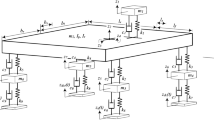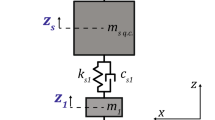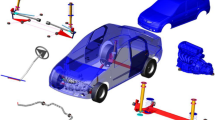Abstract
Optimization techniques are useful tools to the design of complex systems. Especially in case of multiple conflicting performance indexes, the knowledge of the tradeoffs by means of Pareto optimality can help the designer to achieve the best solution. Due to the increasing power of the computing tools, more and more accurate and time consuming models are used. In this case, the Pareto set computation can be a hard task (the Pareto set can be nonconvex, nonlinearities and discontinuities can occur) and the efficiency and the accuracy become crucial features for an optimization algorithm. In this paper an optimization algorithm based on local approximation of the objective and constraints functions is presented and tested with some well known test functions. The optimal design of the suspension system of a ground vehicle is performed by the new algorithm in order to reach the best tradeoff by means of road holding, comfort, working space and cornering behavior. The numerical results show that the proposed algorithm has good accuracy and high efficiency if compared to some widely used methods. The results are explained providing some general observations on the efficiency of local approximation based algorithm an other well known algorithms.

















Similar content being viewed by others
References
Das I, Dennis J (1997) A closer look at the drawbacks of minimizing weighted sum of objectives for Pareto set generation in multicriteria optimization problems. Struct Optim 14(1):63–69
Das I, Dennis J (1998) Normal boundary intersection: a new method for generating Pareto optimal points in multicriteria optimization problems. SIAM J Optim 8(4):631–657
Deb K, Thiele L, Laumanns M, Zitzler E (2005) Scalable test problems for evolutionary multiobjective optimization. In: Abraham A et al. (eds) Evolutionary multiobjective optimization. Springer, London, pp 105–145
Eberhart RC, Kennedy J (1995) A new optimizer using particle swarm theory. In: Proc 6th int symposium on micromachine and human science, Nagoya, pp 39–43
Fadel G, Li Y (2002) Approximating the Pareto curve to help solve bi-objective design problems. Struct Optim J 23(4):280–296
Gobbi M, Mastinu G (2001) Analytical description and optimisation of the dynamic behaviour of passively suspended road vehicles. J Sound Vib 245(3):457–481
Gobbi M, Mastinu G (1999) Global approximation: performance comparison of different methods, with an application to road vehicle system engineering. In: Haque I et al. (ed) Innovation in vehicle design and development. DE, vol 101. ASME, New York, pp 15–24
Gobbi M, Levi F, Mastinu G (2004) Multi-objective design of the suspension system of road vehicles. Veh Syst Dyn 41:537–546. Supplement
Goel T, Vaidyanathan R, Haftka RT, Shyy W, Queipo NV, Tucker K (2007) Response surface approximation of Pareto optimal front in multi-objective optimization. Comput Methods Appl Mech Eng 196:879–893
Goldberg DE (1989) Genetic algorithms in search, optimization and machine learning. Addison Wesley, New York
Haykin S (1998) A comprehensive foundation, 2nd edn. Prentice Hall, Upper Saddle River
Hrovat D (1993) Applications of optimal control to advanced automotive suspension design. ASME J Dyn Syst Meas Control 115(2B):328–342
Kirkpatrick S, Gelatt CD, Vecchi MP (1983) Optimization by simulated annealing. Science 220:671–680
Kuhn HW, Tucker AW (1951) Non linear programming. In: Proc 2nd Berkely symposium on mathematical statistics and probability, Berkely, pp 481–492
Maginot J, Guenov M, Utyuzhnikov S (2008) Local Pareto approximation for multi-objective optimization. Eng Optim 40(9):821–847
Mastinu G (1994) Automotive suspension design by multiple objective programming. In: Proc int symposium on advanced vehicle control (AVEC’94), Tsukuba, Japan, pp 73–78
Mastinu G, Gobbi M, Miano C (2006) Optimal design of complex mechanical systems. Springer, Berlin
Messac A, Mattson CA (2004) Normal constraint method with guarantee of even representation of complete Pareto frontier. AIAA J 42(10):2101–2111
Messac A, Ismail-Yahaya A, Mattson CA (2003) The normalized normal constraint method for generating the Pareto frontier. Struct Multidiscip Optim 25(2):86–98
Michalewicz Z (1994) Genetic algorithms + data structures = evolution programs. Springer, Berlin
Miettinen K (1999) Nonlinear multiobjective optimization. Kluwer Academic, Boston
Mitschke M (1990) Dynamik der Kraftfahrzeuge. Springer, Berlin
Myers RH, Montgomery DC (1995) Response surface methodology: process and product optimization using designed experiments. Wiley, New York
Niederreiter H (1987) Random number generation and quasi-Monte Carlo methods. Society for Industrial and Applied Mathematics, Philadelphia
Papalambros PY, Wilde DJ (2000) Principles of optimal design. Cambridge University Press, New York
Statnikov RB, Matusov JB (1995) Multicriteria optimization and engineering, 1st edn. Chapman & Hall, New York
Tappeta RV, Renaud JE, Messac A, Sundararaj GJ (2000) Interactive physical programming: tradeoff analysis and decision making in multicriteria optimization. Comput Control, AIAA J 36:219–226
Tezuka S (1995) Uniform random numbers: theory and practice. Kluwer Academic, Boston
Van Beers WCM, Kleijnen JPC (2003) Kriging for interpolation in random simulation. J Oper Res Soc 54(3):255–262
Zhang WH (2003) On the Pareto optimum sensitivity analysis in multicriteria optimization. Int J Numer Methods Eng 58(6):955–977
Zhang Q, Liu W, Tsang E, Virginas B (2010) Expensive multiobjective optimization by MOEA/D with Gaussian process model. IEEE Trans Evol Comput 14(3)
Zitzler E, Knowles J, Thiele L (2008) Quality assessment of Pareto set approximations. In: Branke J (ed) Multiobjective optimization. Springer, Berlin, pp 373–404
Author information
Authors and Affiliations
Corresponding author
Appendix
Appendix

Rights and permissions
About this article
Cite this article
Gobbi, M., Guarneri, P., Scala, L. et al. A local approximation based multi-objective optimization algorithm with applications. Optim Eng 15, 619–641 (2014). https://doi.org/10.1007/s11081-012-9211-5
Received:
Accepted:
Published:
Issue Date:
DOI: https://doi.org/10.1007/s11081-012-9211-5




